FCC Lead Generation Rules: How To Ensure Compliance With 1-1 Consent
Disclaimer: The views expressed in this article are our own, and should not be relied upon in place of legal advice – you should seek independent legal advice on compliance issues.
Do you generate leads, whether for sale or internal use?
If so, you should by now be familiar with the new FCC lead generation rules, which come into force on January 27, 2025. The risk of non-compliance is huge, with hefty fines on the line.
The new regulation aims to close what the FCC described as “the lead generation loophole”, and is designed to protect consumers from unethical practices, indiscriminate robo-calls and unwanted text messages.
In brief, the new rules introduce the concept of “one-to-one consent”, amongst other consumer protections. Lead generators will no longer be able to gain valid consent by naming multiple lead generation partners, and will instead need to gain consent for each each individual business the consumer will receive robocalls or texts from.
Our opinion on the new rules
It may be controversial to say it, but we actually see where the FCC are coming from on this one.
We’ve previously seen unethical – but legal – lead generation forms that send the user’s information to any number of up to 150 possible partners. A consumer might one minute be comparing solar prices, and the next getting a surge of calls from companies they have never heard of.
We believe these practices can not only damage consumer trust in the industry as a whole, but can lead to low conversion rates further down the funnel, reducing long term revenue per lead and damaging revenue.
In this article, we’ll break down the FCC’s one-to-one consent rule and show you how to get compliant.
You’ll learn how the new rules affect your business, how to become compliant, how to document compliance with tools like TrustedForm and Jornaya – and finally – how to build a lead-generating machine that adds value for all parties.
Table of Contents
What is the FCC’s 1-1 consent rule?
The 1-to-1 consent rule, also known as the one-to-one consent rule, is a new regulation aimed at protecting consumers from unwanted and illegal text messages and calls.
This rule mandates that businesses obtain a consumer’s “prior express written consent” that is specific to each individual seller before sending any marketing communications.
That’s right – you will now need to gain separate consent for each individual business that contacts your lead through SMS or automated means – it’s no longer good enough to ask users to consent to being contacted by a list of possible lead buyers.
What do the new rules require?
- One-to-one consent – When generating leads, you must obtain the consumer’s express written consent separately for every organization that contacts them using robocall or robotext technology – it’s no longer enough to rely on blanket lists or specify multiple partners.
- Clear and conspicuous disclosure – You can’t bury the disclosure in fine print, hide it in a hyperlink or make it barely visible – the disclosure must be “apparent to a reasonable consumer”.
- Logically and topically related calls – If the user does give consent, it is only valid for “logically and topically related calls”. To give an example, a user enquiring about auto insurance might not have provided valid consent to receive marketing calls for debt consolidation.
- Documentation of consent – Since the burden of proof is on the texter or caller, it’s more important than ever to document consent, so that you can prove that it was collected if challenged. Growform’s 1-click integrations with Trustedform and Jornaya make this simple.
How to get compliant with the FCC Lead Generation Rules
1 – Get consent for each individual lead buyer rather than a long list
If you’re currently listing a number of businesses who might contact the user, this will not be compliant under the new rules:
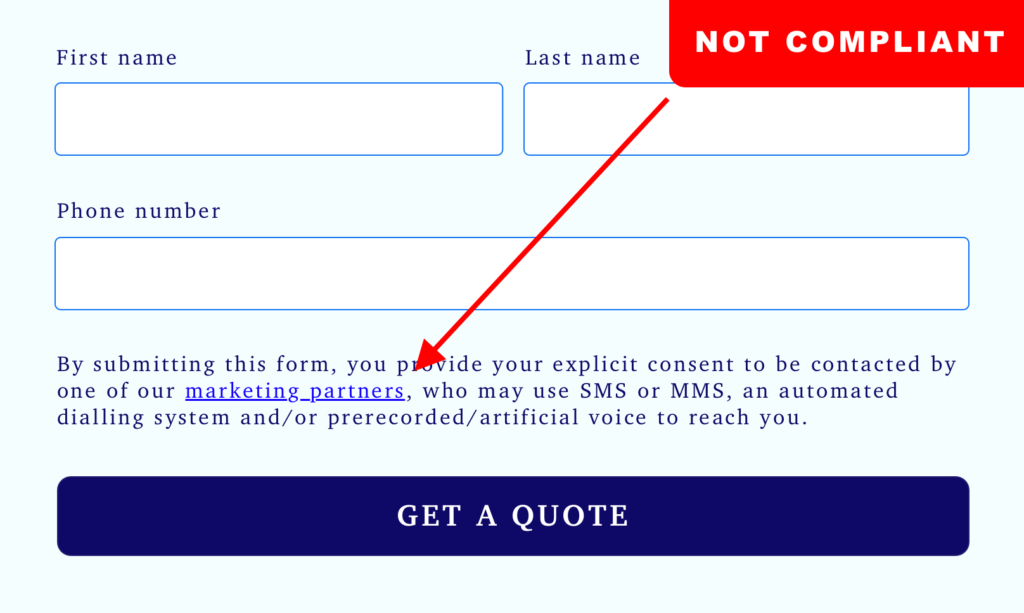
Instead, you must gather consent for every partner who will contact the user via robocall/text. This is straightforward if you’re selling exclusive leads to a single buyer – this is a minimal example of a form we that believe would fulfil the requirement of one-to-one consent:
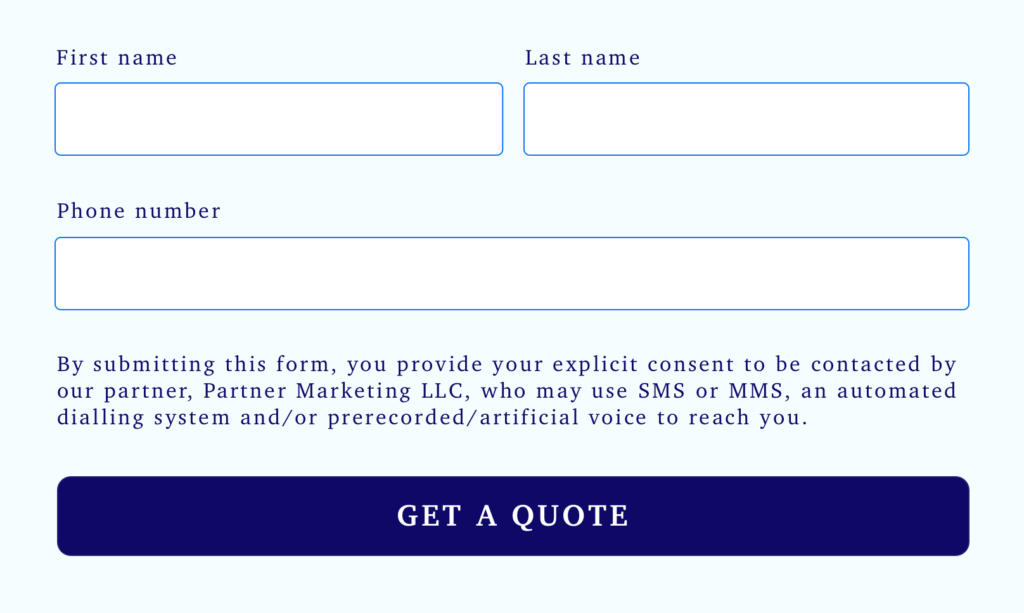
Need to create a form like this? Growform lets you create FCC compliant forms with ease.
This example covers exclusive leads to a single buyer, but what if many companies might contact the lead? We cover this in the multiple buyers scenario.
2 – Ensure clear and conspicuous disclosure
If you currently rely on terms and conditions hidden behind a hyperlink, buried in small print or that is barely visible – this is not compliant.
The following form would not be compliant, as the disclosure is not “clear and conspicuous” – in this example, is behind a hyperlink:
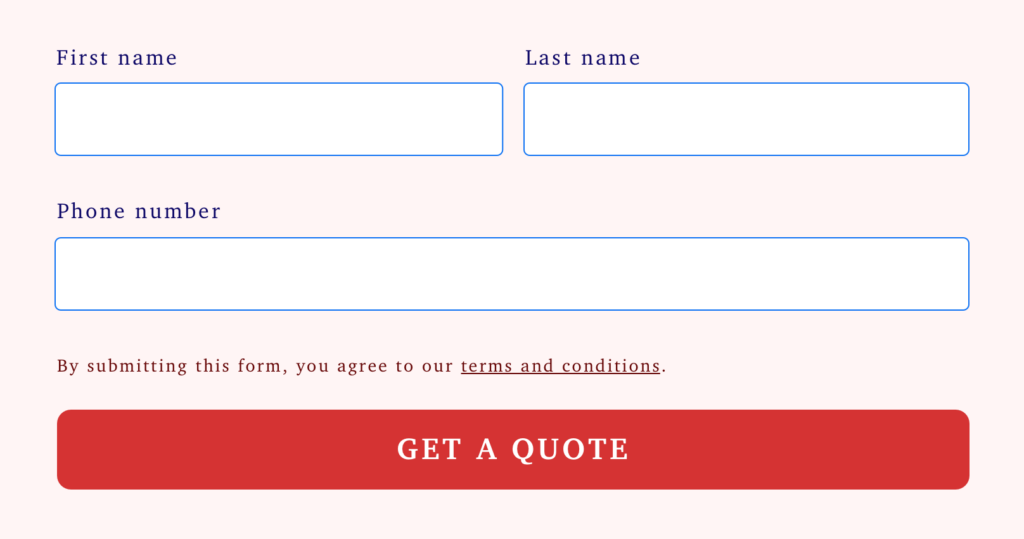
Instead, you should make sure that any disclosure is clear and conspicuous, and “apparent to a reasonable consumer”.
In our opinion, including the disclosure in reasonably sized text, that is legible and obvious to the user should meet this requirement.
3 – Ensure logically and topically related calls
The content of any resulting robotexts and robocalls must be “logically and topically related”, so we’d advise being more careful with who to send data to.
This might not necessarily affect our customers (legal lead generation customers generally send data to lawyers!), but it’s worth taking the opportunity to tighten up your seller list and err on the side of caution.
4 – Document and prove your compliance
As these new regulations are intended to champion the rights of the consumer, you should expect that some consumers will rightly take issue with being contacted.
Any time you collect user consent for the purposes of TCPA / FCC regulations, you should document the consent, including the specific consent and any TCPA disclosures seen.
To automatically document compliance, you can use a solution like TrustedForm and/or Jornaya.
Need to document compliance on your forms? Growform offers 1-click integrations with popular compliance platforms like Trustedform and Jornaya.
Is your form compliant? Check here!
Exclusive leads: Selling leads to one, static lead buyer only
If you’re selling exclusive leads to only one, static lead buyer, you’re in luck.
The new FCC lead generation rules should have a minimal impact on your form configuration and business model.
You’ll need to ensure that your lead capture form clearly identifies the lead buyer and obtains the consumer’s prior express written consent to receive robocalls/texts from that specific buyer.
To achieve the highest level of compliance, make sure your form includes:
- The name of the single lead buyer
- A clear disclosure that the consumer is agreeing to receive robocalls or texts from the identified buyer
- An easy way for the consumer to provide their signature or agreement, such as a checkbox or e-signature
- Automatic documentation to prove the user’s consent (via Jornaya or Trustedform)
By implementing these steps, you can continue selling leads to your single buyer without major changes to your process.
With these minor changes, we would expect your form to be compliant, with no major impact on your business model, conversion rate or economics.
Here is a simple example of a form that we would expect to achieve compliance, when sharing leads with a fictional partner called “Partner Marketing LLC”:
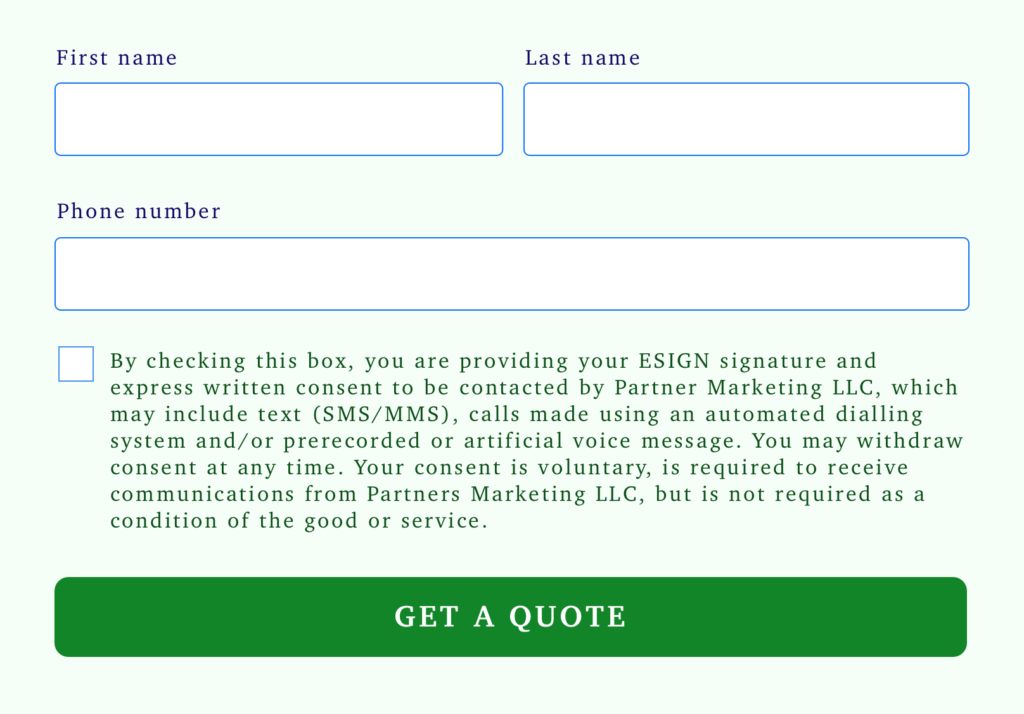
Technical implementation is straightforward – you can use a form builder like Growform to create a form with a checkbox disclosure, and enable integrations with tools like Jornaya and Trustedform to document consent.
Non-Exclusive leads: Selling leads to a few static lead buyers only
If you’re selling leads to a small number of static lead buyers, complying with the new FCC lead generation rules shouldn’t be too difficult.
The key is to ensure that consumers can provide their prior express written consent to each individual buyer.
To meet the requirements, your form should:
- List each lead buyer separately and clearly
- Allow consumers to select or deselect each buyer individually, such as through checkboxes
- Include a disclosure that the consumer is agreeing to receive communications from the selected buyers
- Have the ability to document / prove the user’s consent
Of course, you should ensure that your system doesn’t send leads to any third parties who the user did not consent to receiving communications from.
We believe the following screenshot should illustrate a compliant form, as the user is able to provide 1-1 consent for each partner:
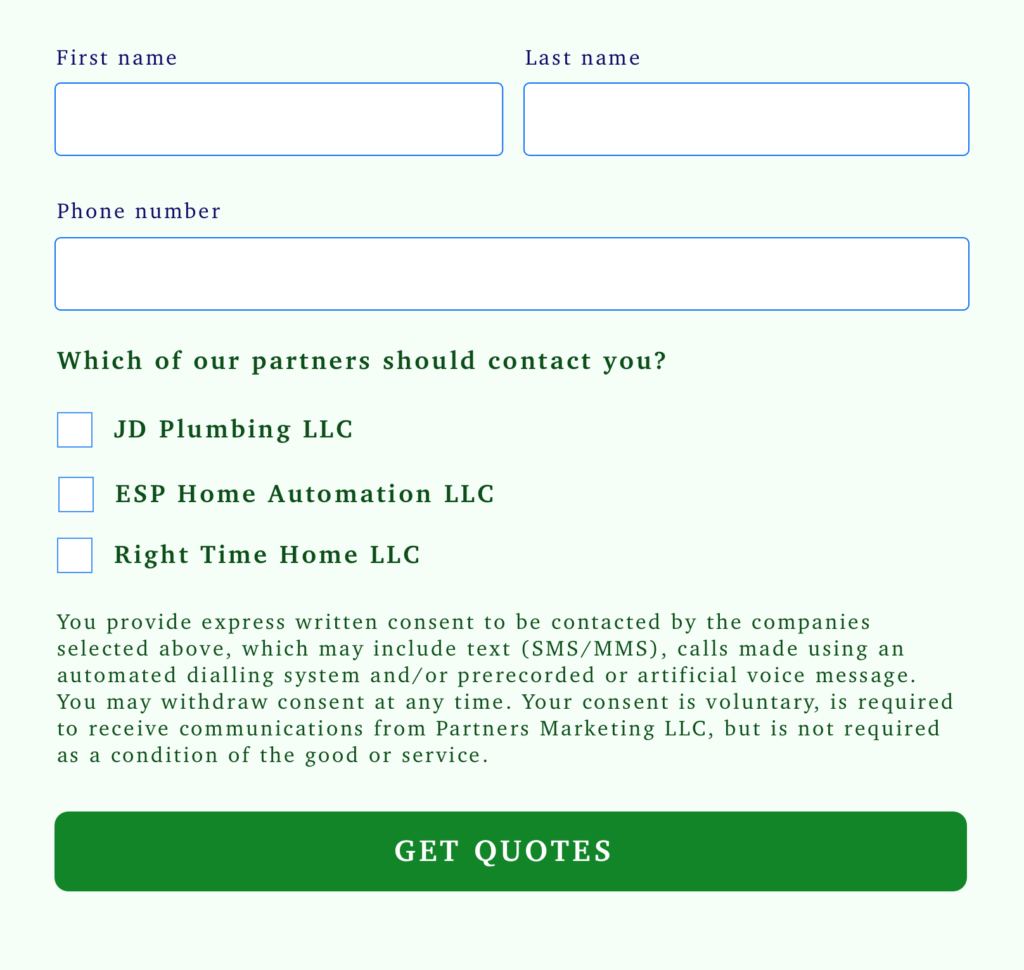
Compliance here is relatively straightforward, since the lead buyers are static and can be hardcoded into the form.
Need to create a form like this? Growform makes it easy to create forms with checkboxes, TCPA disclosures and consent documentation.
But what happens if you have a long list of possible lead buyers? What if, at the time the user is supposed to be providing consent, you don’t actually know who will be buying the lead? We solve for this eventuality in the next section…
Exclusive leads: Selling leads to one buyer from a long list of possible buyers (dynamic consent)
If your business model involves selling leads to one buyer selected from a long list of potential buyers, you’ll need to take extra steps to ensure compliance.
The end result will be very similar to our “Selling leads to one, static lead buyer only“ example, but with a little extra technical wizardry to ensure the buyer sees (and provides consent for) the correct lead buyer.
But how can we collect the user’s consent for a particular lead buyer, when we don’t yet know which business will contact them?
This is where dynamic consent comes in.
By integrating your lead capture form with a lead distribution tool (this is often called “ping post” or a “ping tree”) – the form can instantly “look up” the buyer of the lead and display their name on the consent disclosure.
The consumer can then agree to receive communications from the specific buyer – and compliance is achieved!
To meet the requirements for compliance, your form should include:
- A dynamic TCPA disclosure that updates with the name of the winning lead buyer
- A clear explanation that the consumer is consenting to communications from the displayed buyer
- A signature or agreement method, such as a checkbox.
- Ability to document / prove the user’s consent
Here is a screenshot of a form that we believe would achieve compliance:

Need to to capture dynamic consent? Growform are working on a solution – sign up for updates.
You should document the agreed consent, which will include the name of the lead buyer the consumer agreed to receive communications from.
Non-exclusive leads: Selling leads to multiple buyers from a list of possible buyers (dynamic consent)
Selling leads to multiple buyers from a long list of potential buyers is perfectly possible under the new FCC regulations, but is the most challenging scenario in terms of implementation.
To achieve compliance, you’ll need to implement a system that allows consumers to provide their prior express written consent to each individual business that will contact the user.
This can be achieved with dynamic consent:
- In the first step, the consumer provides their basic information (such as a zip code and services needed)
- In the second step, the consumer is presented with a list of the specific service providers. They can then select or deselect each buyer individually and provide their express written consent to receive communications from the chosen entities.
Your forms should include:
- Disclosures that inform the user how their data will be processed
- A way for the consumer to individually select or deselect each matched buyer, such as checkboxes
- A way of documenting/proving the user’s consent.
Growform is working on a solution that will allow consent / selection of lead buyers looked up from an external “ping”:
For more information on our ping/post dynamic consent solution, sign up for updates here.
Documenting consent collection and TCPA disclosure
Proper documentation is essential for maintaining compliance with the FCC’s one-to-one consent rule. For every lead obtained, you must be able to prove that the consumer provided prior express written consent to each individual buyer.
This documentation should include:
- The specific consent language used on your lead capture form
- The list of buyers presented to the consumer for selection
- The consumer’s affirmative agreement to receive communications from each selected buyer
- The date and time of the consumer’s consent
- The consumer’s signature or other method of agreement (e.g., checkbox, e-signature)
It’s important to note that the burden of proof for valid consent falls on the caller or texter, not the lead generator or website publisher. While you may rely on lead generators to obtain and document consent, it’s ultimately your responsibility to ensure that the consent meets the necessary requirements.
Under the Federal Trade Commission’s (FTC) Telemarketing Sales Rule (TSR), businesses conducting communication outreach must retain these records for a minimum of five years from the date consent was given and outreach occurred. Maintaining this documentation is crucial, as it can provide essential evidence in the event of a regulatory investigation or legal dispute, serving as proof that proper consent was obtained.
To streamline the consent documentation process, you can enable TrustedForm and Jornaya Lead ID on your form. These platforms allow you to automatically capture and store the necessary proof of consent, including the specific language used and the consumer’s affirmative agreement. Growform has a 1-click integration with these tools.
FAQs
How are inbound calls affected? How about click-to-call?
Inbound calls, including click-to-call calls, are generally not impacted by the new FCC rules, as the regulation targets outbound communications, such as robocalls and robotexts.
However, if the inbound call leads to any future marketing or communication outreach (via automated calls or texts), you’ll still need to ensure that proper consent is collected for those actions.
What if we / our lead buyers aren’t using robocall or robotext?
The FCC rules appear to specifically tackle robocalls and text messages, so we believe manually dialled calls should fall outside of these new requirements.
However, if there’s any chance that automated communication will be used in the future, it’s safer to obtain explicit one-to-one consent upfront to avoid compliance issues later on.
Many of our customers are choosing to opt for compliant lead collection practices regardless of the current communication methods, as it provides legal protection and flexibility. If you’re in any doubt, you should seek legal advice.
What’s the relevance of tools like TrustedForm and Jornaya?
Tools like TrustedForm and Jornaya are vital for compliance, as they provide proof of user consent, which is now required under the FCC’s new regulations.
These tools are designed to capture the exact moment consent is given, including what the user saw on the form and how they agreed to it. This documentation can serve as crucial evidence if the validity of consent is ever questioned by regulators or in legal disputes. Read about these solutions here.
Can I prepopulate checkboxes for consent?
No, we do not believe prepopulating checkboxes for consent is compliant under the FCC’s one-to-one consent rule.
Consent should be an affirmative action taken by the consumer, meaning they need to manually check the box to indicate their agreement. Prepopulated checkboxes could lead to disputes over whether valid consent was given, so you should ensure users are actively choosing to opt in to communication from each individual business.
I have a form where multiple businesses can bid on a lead. How can I get compliant?
If you have multiple buyers bidding on a lead, the FCC’s new rules still apply, meaning you must collect one-to-one consent for each specific buyer who will ultimately purchase the lead.
We wrote about this here.
What is ping/post, and how is it relevant here?
Ping/post is a lead distribution method whereby some limited lead information is first sent to multiple potential buyers (the “ping”), the lead information is sent to one or more successful bidders (the “post”).
If you’re selling leads, you’re already carrying out the “post”, which is simply the moment the buyer is sent the lead.
In this context, a ping-post system allows you to get 1-1 consent for the individual buyer(s) who will be contacting the user. Without ping-post in place, you would have to rely on a blanket list of buyers, which would not be compliant.
In other words, the “ping” enables you to dynamically display the specific buyers interested in the lead, obtain the user’s explicit 1-1 consent for each buyer individually, and ensure compliance. It solves the problem of not “knowing” who will buy the lead (and therefore what the consent wording should be) until at least some form data is entered.
Conclusion
The FCC’s new one-to-one consent rule marks a significant shift in lead generation practices. This change puts consumers in the driver’s seat, giving them more control over who can contact them and what information they receive. By focusing on clear disclosures, specific seller identification, and proper documentation, businesses can build trust with consumers while staying on the right side of the law.
Growform is actively working on a lead generation compliance suite, which lets you gather consent from users no matter how many lead buyers you have.
Disclaimer: The views expressed in this article are our own, and should not be relied upon in place of legal advice – you should seek independent legal advice on compliance issues.
Recent Posts
- 6 Essential Mobile Form Design Best Practices for Higher Conversions
- We Review the Best B2B Lead Generation Tools to Supercharge Your Campaigns
- Typeform Pricing: Uncover Hidden Costs & a Better Alternative
- How to Optimize B2B Lead Scoring for Faster Sales Closures
- Here Are the Best Google Forms Alternatives for More Efficient Data Collection
